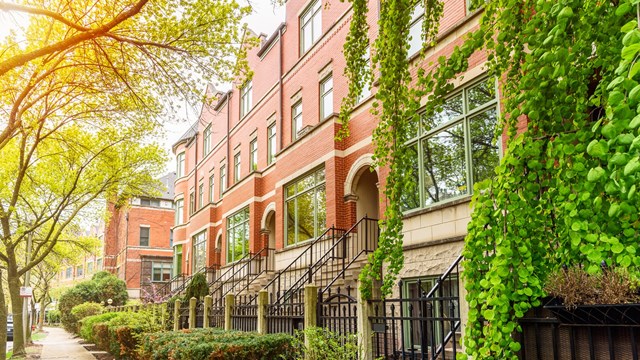When it comes to purchasing a unit in a condominium, co-op, or homeowners’ association, buyers tend to be (rightly) concerned with square footage, baths, beds, kitchen aesthetics – all of the fundamentals people look for in a new home. But before a potential buyer can be sold an apartment, they have to get inside the building. This is where the concept of curb appeal comes in. Regardless of the quality of a product, people tend to evaluate the packaging. The nicer a property looks from the outside, the more optimistic the shopper will be once they’ve crossed that inner threshold.
“Curb appeal absolutely sets the tone for the entire building image,” says Marilyn Sygrove, President of Sygrove Associates Design Group Inc., in New York City. “Number one, how well the building is maintained, how current the materials and design are, and it gives you a sense of quality of the building. If you are in the competitive real estate market and your snow is shoveled, the door hardware is shiny and the glass is clean...that is the image that you want to project in a well-run, well-maintained building.”
As buildings come in all shapes and sizes, curb appeal can take many forms. Such things as window décor, entryway flourishes, and greenery can all play their part. But regardless of what one has to work with, a little care and maintenance can go a long way toward maintaining the value of a property and assuring a return on investment when it’s time to sell.
Essential Elements
What constitutes ‘curb appeal’ can run the gamut, as what one tends to notice about a walk-up in the big city varies from that of a towering residential skyscraper or a suburban townhome. The commonality is an awareness of what makes a property unique and really making those elements pop.
Says Sygrove: “Curb appeal is the facade of the building at eye level, from the condition of the sidewalk, the awning, any plantings or landscaping and entry doors, plus whatever you can visually see into the building—for instance if there is a large window that looks into the lobby.”
“Curb appeal encompasses everything from landscaping to snow removal, and the condition of the exterior, including the paint, doors, and entryway,” explains Rebecca Thomson, Vice President of Agent Development with @properties, in Chicago. “While curb appeal impacts first impressions, it isn’t as crucial in an urban area where other factors like location, proximity to public transportation, building amenities, view, and layout tend to be the drivers in a home search.”
That said, those first impressions are important, and certain considerations can be of help. “In general, a building should have a clean sidewalk, polished brass poles, refinished wood/metal doors, fresh-looking awning, and manicured flower beds, depending on the season,” suggests Georgia Lombardo-Barton, president of Barton Management LLC, in New York City. “There is a good amount of sprucing up that can be done to render a building’s curb appeal inviting.”
Even when space is at a premium, there are tweaks that can be made. “Limited space may reduce your options in terms of square footage, but there are plenty of small-space options to spruce up the outside of a property for potential buyers,” says Christian Schlueter, a real estate agent with RE/MAX at Barnegat Bay, in Toms River, New Jersey. “If there’s no yard, simple window boxes can be added to hold flowers. And if a slightly larger project is feasible, updating shutters and railing for any steps or stoops can do a lot to renew appearances. Also, never underestimate the value of a fresh coat of paint. If replacing siding is out of reach, a freshly-painted door in a clean color will still brighten up an entrance.”
Day Laboring
As for upon whom it falls to keep up these pristine appearances, that can depend on the location, budget, and aesthetics of an individual association. Of course, it never hurts to pinch pennies and handle as much internally as is reasonable.
“The responsibility as to who maintains a property’s exterior can vary,” says Thomson. “In a large high-rise, it often falls to the association or management. In some smaller self-managed associations, the responsibility to coordinate snow removal and landscaping may fall to the residents. If a homeowner is gearing up to sell and is willing to foot the bill on some cosmetic work, more often than not their neighbors will be more than happy to acquiesce.”
Richard M. Holtzman, President of Chicago-based Prairie Shores Management, suggests that it falls to management each year to provide the board of directors with a plan to maintain and improve the property’s curb appeal, which will in turn benefit the residents and their individual investments. “If they refinance or sell, that enhanced value is essential when an appraisal is included in the process,” he says.
If the association has staff to take on the task, curb appeal should be something incorporated into the daily/weekly routine, notes Lombardo-Barton, rather than thought about only every now and again. “Beautification of a building’s curb is just as important as its lobby, and it doesn’t take that much more effort if it is handled each day,” she adds.
“It’s always best to be proactive, not reactive, and maintain the outside of a unit just as one would maintain the interior,” agrees Schlueter. “One of the greatest benefits of homeownership is the pride one takes in their personal space – and that is often directly related to its upkeep and maintenance.”
Dollars and Sense
A well-maintained exterior can certainly draw prospective buyers, but just how essential is it in maintaining a property’s value? Does it move the needle in any significant way?
“Curb appeal may not necessarily add dollar value to a property, but it affects the sights and the smell, and thus may trigger a first-impression sense that the property is well-maintained,” suggests Lombardo-Barton. “The Italians have a saying of making a bella figura, which means that how a person dresses or looks says a lot about them. The same applies to a building exterior. Dress it up as tastefully and as often as possible.”
Holtzman looks at curb appeal as more a piece of a greater whole. “All things being equal, consideration for architecture, lighting, condition of the facade, and common area aesthetics are crucial to achieving an enhanced value” for a property, he says.
There’s a reason that real estate listings often lead with an exterior shot as the primary photo, notes Thomson. “Curb appeal is important for getting someone in the door. Sometimes you only get that first impression. The greater the appeal, the larger the pool of buyers who might be inclined to purchase.
“The biggest challenge sellers have is that people tend to remember the negative things about a home,” she continues. “When you see eight places in one showing, or look at 50 properties via photos online, you tend to remember the house with the grumpy cat or the orange kitchen. As a seller doesn’t want to be remembered for something negative, their goal should be to reduce the number of distractions, so people can focus on the great features of the home.”
“It’s a first-impression business, and you want to make a good one,” urges Schlueter. “Some buyers can look at a property and imagine themselves existing there without a problem. But most of the time, buyers don’t have the ability to visualize the potential of a property without a little help.”
Quick Fixes
Even when in a pinch with little time or budget to spruce up the outside of a property, there are still things an association can do to kick the aesthetic up a notch.
“Painting the front door or shutters is an easy and cost-effective way to change the outdoor appearance and give a unit a new look with limited time and money,” suggests Schlueter. “If paint is out of the question, consider changing the exterior lighting to something more impressive, or just add a few potted plants for some color around the entryway.”
Simply shoveling and salting the walkways during the winter can be a value-add, says Thomson. “It’s about both ensuring that the property is safe and easy to get into, and avoiding a liability issue for any association, whether your building has two owners or 2,000. Other fixes include making sure that the lights are in good working order, the windows are clean, paint is touched up, and there is no visible damage.”
“Making sure that the sidewalk is deodorized and washed is very important,” adds Lombardo-Barton. “You don’t want to smell pet excretion or garbage. Have the door panes cleaned and the brass or metal handles polished, along with the door saddles and light fixtures. Wipe away any signs of dirt, debris, or cobwebs. If there are ground-floor windows with flower boxes facing the front of the building, plant a few colorful annuals or simple small boxwoods. Same with outdoor planters, flower beds, and tree pits.”
All of this will make for very happy house—or apartment—hunting, indeed.
Mike Odenthal is a staff writer and reporter for The Chicagoland Cooperator.










Leave a Comment